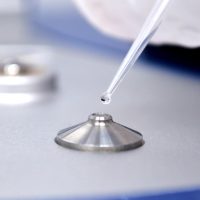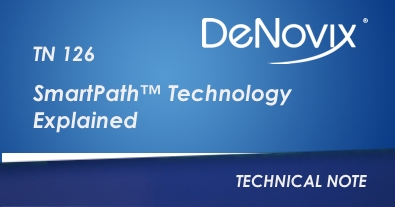Introduction
Small volume spectrophotometers, such as the DeNovix DS-11 Series and DS-8X Eight Channel Spectrophotometer, enable quantitative measurements using volumes as small as 0.5 (DS-11) to 1 μL (DS-8X). To make a measurement, the sample of interest forms a liquid bridge between the upper and lower sampling surfaces. The accuracy of the results is dependent on the accuracy of a calibrated distance between the two measurement surfaces. This note will explain how the DeNovix SmartPath™ technology ensures that the measurement distance (pathlength) stays within specification, resulting in accurate, reproducible results.
Pathlength and Sample Concentration
The DS-Series software uses the Beer-Lambert equation when calculating sample concentrations. This equation correlates the absorbance to both the concentration as well as the pathlength the light travels through a sample. It is generally written as:
A = εbc
A: absorbance value
ε: absorptivity coefficient with units of L /mol*cm
b: pathlength of the sample expressed in terms of cm
c: concentration of the sample in solution expressed in mol/L
Higher concentration samples require shorter pathlengths. Microvolume mode uses real-time absorbance data to determine the optimal pathlength for each sample. The software will automatically move the arm down as needed to ensure that the measurement is made using the optimal pathlength.
For example, the DS-11 Series microvolume mode uses pathlengths ranging from 0.5 mm down to 0.02 mm.
Exquisite Pathlength Control
SmartPath technology uses opto-mechanical components and proprietary algorithms. Together, they provide accurate pathlength control and deliver performance unmatched by any microvolume spectrophotometer.
The technology uses a fine-pitched, high-precision optical adjustment screw, a high motor gear ratio and high resolution control to adjust the pathlength to within 1 micron. This translates to +/- 0.2% at 500 microns and +/- 3% for ultra short pathlengths.

No Recalibration Required
The DS-11 and DS-8X instruments make use of a reference position, which is set at our factory during calibration. Each time any measurement app is launched, the exact motor position relative to the reference position is known. A calculation is then used to determine how many motor rotations are necessary to move to the required pathlength. Shorter pathlengths are easily achieved since the rotation to pathlength relationship is well characterized.
During typical use, the instruments monitor the pathlength accuracy using proprietary software algorithms and perform the necessary adjustments as required.
Summary
The DeNovix DS-11 and DS-8X, in conjunction with SmartPath technology, provide precise pathlength control and achieve performance unrivaled by any other microvolume spectrophotometers.
30-SEP-2024



